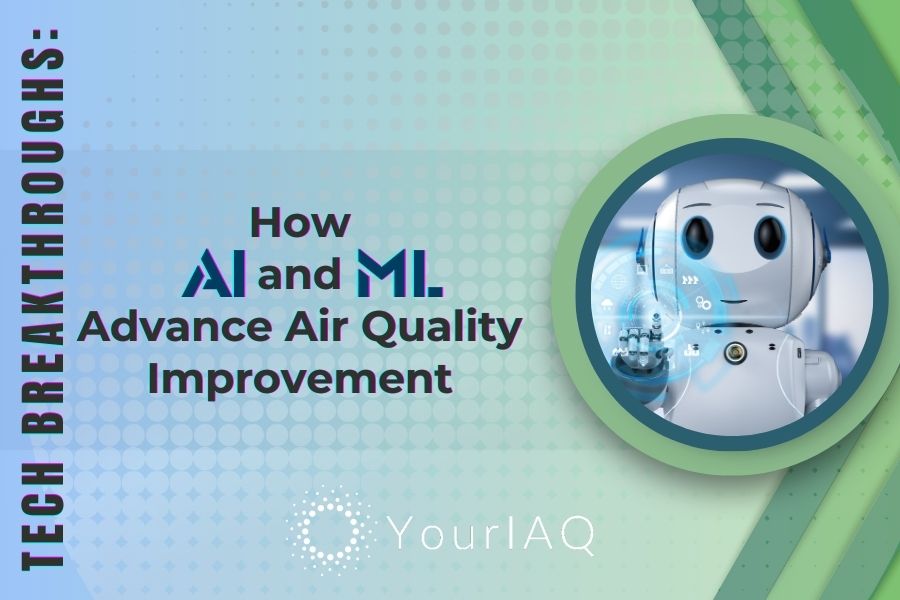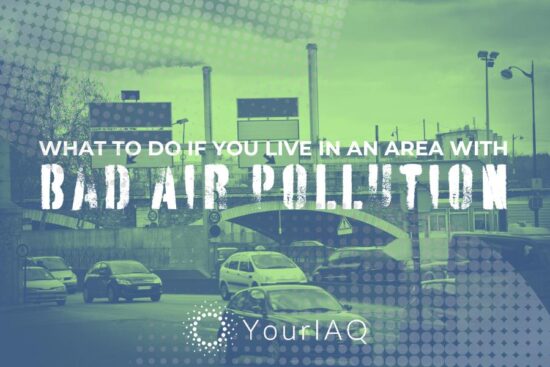
The air we breathe indoors matters. In fact, we spend 90% of our time inside, breathing air that can be up to five times more polluted than the air outside. Fortunately, technology is stepping up to help us breathe easier. Enter AI (Artificial Intelligence) and ML (Machine Learning), the dynamic duo revolutionizing indoor air quality (IAQ) management.
With the advent of AI-driven HVAC optimization, real-time IAQ monitoring, and smart IAQ technologies, we don’t have to just react to air quality issues; we can predict and prevent them.
AI’s role in enhancing IAQ is multifaceted. It includes:
- Sensors and IoT Devices
- Machine Learning Algorithms
- AI-powered Solutions
With the use of AI, we can better understand the importance of clean air and ensure we’re breathing it. Let’s dive into AI’s capabilities in detecting, analyzing, and predicting air quality issues, offering unprecedented control over the air we breathe.
The Evolution of AI in Monitoring Indoor Air Quality
The growing awareness of Indoor Air Quality’s (IAQ) critical role has catalyzed significant investment in AI technologies for air quality monitoring. As of 2023, the market was valued at almost USD 4.89 billion, highlighting a major transition towards utilizing technology to protect health and enhance well-being.
Projected to expand at a Compound Annual Growth Rate (CAGR) of 6.4% from 2024 to 2032, the market is anticipated to reach around USD 8.55 billion by the conclusion of this forecast period. This expected growth underlines the escalating commitment to and integration of AI and IoT technologies for the real-time monitoring and management of air quality.
Such a historical shift underscores the profound influence of technological advancements on IAQ monitoring, signifying a crucial transition from mere detection to in-depth, predictive analysis and management, which we will highlight in the next section.
Historical Overview of IAQ Monitoring
From its rudimentary beginnings to the sophisticated IoT and AI-driven systems of today, IAQ monitoring has undergone a remarkable transformation. Each advancement has brought about a deeper understanding of indoor air quality, enabling more effective management strategies and healthier indoor environments.
Here’s a brief timeline:
Manual Inspections and Basic Sensors
Initially, IAQ assessments were primarily visual, focusing on obvious signs of mold, dampness, or soot. There were also simple chemical tests used to detect specific pollutants like carbon monoxide or radon, offering very basic information.
Early mechanical devices, such as carbon monoxide detectors, provided limited data based on color changes or needle movements.
Transition to Digital Monitoring
The introduction of digital sensors marked a significant advancement, enabling more accurate measurements of pollutants like VOCs and particulate matter. These devices began to track air quality over time, storing data for later analysis, but still required manual interpretation.
Integration of Advanced Technologies
Equipped with the ability to detect a wider array of pollutants, smart sensors improved the accuracy and range of IAQ monitoring. The use of Wi-Fi and Bluetooth allowed for the remote monitoring of IAQ, transmitting data to computers or smartphones for analysis.
Systems integrated with HVAC controls could adjust air filtering or ventilation based on the detected air quality, offering a more proactive approach to IAQ management.
The Era of IoT and AI
Recent advancements with the Internet of Things (IoT) have connected multiple sensors across buildings for comprehensive monitoring, collecting vast amounts of data on IAQ.
| What is IoT and how does it work in air quality monitoring?
IoT refers to the network of physical devices embedded with sensors, software, and other technologies that collect and exchange data over the internet. In the context of air quality monitoring, these devices can be standalone sensors or integrated into smart home systems. They typically measure various air quality parameters such as:
The collected data is transmitted wirelessly to a central hub or cloud platform, where it can be analyzed, visualized, and acted upon. This information is accessible through smartphone apps or dashboards, gaining real-time insights into their air quality and potential health risks. |
How AI Transforms IAQ Monitoring
AI, with its ability to process and analyze vast amounts of data rapidly, brings a level of precision and efficiency previously unimaginable. Here’s how AI transforms indoor air quality monitoring, thereby improving it:
Real-time Data Analysis
In a Hindawi study published in the Journal of Sensors, an IoT-based indoor air quality monitoring device called “Smart-Air,” showcases the seamless blend of IoT with cloud computing technology for continuous monitoring of air quality parameters.
The Smart-Air device has a microcontroller, pollutant detection sensors, and an LTE modem for real-time data transmission to a web server. It can measure concentrations of aerosol, volatile organic compounds (VOC), carbon monoxide (CO), carbon dioxide (CO2), and temperature-humidity levels, offering a comprehensive overview of indoor air quality.
Rigorous testing, following the guidelines from the Ministry of Environment, Korea, has verified the reliability of this device, affirming its capability to provide accurate and real-time air quality assessments.
Predictive Analytics for Identifying Potential Issues
Perhaps the most groundbreaking aspect of AI in IAQ monitoring is its predictive capability. By analyzing historical data and identifying patterns, AI can forecast potential air quality issues before they become a problem.
NOAA and Mayday.ai
Advancements in artificial intelligence (AI) combined with the open access to public data provided by the National Oceanic and Atmospheric Administration (NOAA) are ushering in a new era of early warning systems.
Mayday.ai exemplifies this transformative approach by harnessing AI to interpret NOAA data, employing machine learning techniques that can penetrate cloud cover to identify wildfires significantly quicker than conventional methods—up to 15 minutes faster. This crucial head start provides valuable time for evacuations, resource allocation, and emergency response, potentially saving lives and livelihoods.
“NOAA’s BDP was a game-changer,” says Mirshahi, CEO of Mayday.ai. “It gave us the data and computing power we needed to develop our wildfire detection system, which wouldn’t have been possible before.”
ICEEMDAN-WOA-ELM-FCE predictive model
A 2019 study introduced a predictive framework composed of two models for prediction and evaluation, demonstrating the potential for enhancing the forecasting and management of air quality. This model successfully forecasted the levels of air pollutants, and the evaluation outcomes were sufficiently satisfactory compared to real conditions, indicating that it can fulfill the criteria for early warnings.
| Insight:
AI’s role in enhancing IAQ is transformative. It marks a shift from reactive to proactive management, where you’re not just responding to issues as they occur but preventing them from happening in the first place. Integrating machine learning algorithms and intelligent IAQ solutions into our daily lives underscores a commitment to better air quality and healthier, more sustainable living environments. |
Innovations in Smart Home Technology for IAQ Management
The advent of AI in smart home technology has revolutionized Indoor Air Quality (IAQ) management, bringing forth innovations that enhance air quality and integrate seamlessly into our daily lives.
Here are some key advancements, along with examples of real-life devices embodying these innovations:
Air Sensor Technology
Modern air sensors go beyond traditional monitoring, offering detailed insights into various pollutants and enabling smart ventilation systems to react dynamically.
We recommend the Sensables Air Quality Monitor. This monitor can detect over 20 harmful pollutants, including those prioritized by the EPA, and send alerts when air quality levels become concerning.
See also: 10 San Diego Startups Leading the Way in Sensor Technology
Smart HVAC Integration
Smart thermostats and HVAC systems now utilize AI to learn from your habits, adjusting heating, cooling, and ventilation to maintain ideal IAQ levels without manual input.
Example Devices:
- Nest Learning Thermostat: This device can learn your schedule and adjust temperature and humidity levels, improving IAQ and energy efficiency.
- Ecobee SmartThermostat: Uses room sensors to manage hot or cold spots, ensuring consistent IAQ throughout the home while optimizing energy use.
Predictive Air Quality Alerts:
Thanks to AI’s predictive capabilities, you can now receive notifications about potential IAQ issues before they become problematic.
Example Technologies:
- Plume Labs Flow 2: A portable air quality monitor that predicts pollution levels and provides alerts through a mobile app, helping you avoid exposure to poor air quality.
- IQAir AirVisual Pro: Offers real-time air quality monitoring along with weather forecasts to predict air quality trends, sending alerts to adjust indoor conditions preemptively.
Voice-Activated Air Quality Checks
With smart speakers and assistants, you can ask simple questions to determine the current state of your indoor air.
Real-Life Application:
Amazon Echo & Awair Skill: By pairing your Echo device with the Awair air quality monitor, you can ask Alexa about the air quality and receive real-time updates. Try saying, “Alexa, ask Awair how my air quality is,” which provides you with an instant overview of your indoor environment.
Or try saying, “Activate allergy mode!” (assuming the device has this feature), which triggers customized settings on your air purifier and smart thermostat, optimizing filtration and temperature for allergy relief.
Beyond just receiving updates, you can now command your IAQ systems to adjust settings based on your immediate needs, such as activating specific modes for allergies.
Amazing, isn’t it?
Real-Life Application:
Google Home & Dyson Pure Cool Link: Integrating your Google Assistant with a Dyson Pure Cool Link allows you to control the air purifier using voice commands. You can say, “Hey, Google, turn on the Dyson purifier to allergy mode,” prompting the device to adjust its settings to tackle allergens more aggressively.
Air Purification Advancements
Smart air purifiers now use AI to adapt their filtration speed based on real-time air quality readings, ensuring efficient pollutant removal.
Example Devices:
- Dyson Pure Cool: Purifies the air and reports live IAQ levels via its LCD and app, adjusting its settings automatically in response to detected pollutants.
- Philips Series 3000i: Uses AeraSense technology to detect IAQ changes and automatically increases fan speed to reduce pollutants.
Integrated Home Ecosystems
The holistic integration of IAQ management into smart home ecosystems allows for a comprehensive approach to air quality, where multiple devices communicate and adjust settings in harmony.
Example Ecosystems:
Apple HomeKit: Allows for integrating various IAQ sensors and devices, enabling users to automate responses such as activating air purifiers or adjusting HVAC settings based on the air quality data collected.
These advancements in smart home technology for IAQ management provide a healthier living environment and offer convenience, energy efficiency, and peace of mind, demonstrating the power of AI to transform our living spaces.
4 Benefits of AI-Driven Monitoring Systems
Benefit #1. Enhanced Accuracy of Air Quality Monitoring
With AI, the days of guesswork and approximations are gone. Sensors and IoT devices collect data precisely, while machine learning algorithms analyze this information, ensuring that you get not just data but insights.
This means you’re always informed about the air quality in your space, with alerts and updates tailored to your environment. Real-time IAQ monitoring becomes not just possible but standard.
Benefit #2. Predictive Maintenance of Air Quality Systems
AI shines in its ability to foresee and prevent. Through predictive analytics, AI anticipates potential issues with your HVAC and air purification systems before they escalate. This not only ensures that your air quality remains uncompromised but also extends the lifespan of your systems.
Benefit #3. Personalized Air Quality Management Solutions
Imagine an air quality system that knows your preferences, needs, and even your schedule. AI makes this a reality, offering personalized air quality management solutions.
Whether it’s adjusting the humidity levels to your comfort or ensuring the air is purified just before you arrive home, AI tailors the indoor environment to suit you perfectly. Personalized solutions mean that IAQ management is no longer one-size-fits-all but uniquely yours.
Benefit #4. Contribution to Sustainable Building Management
By optimizing energy use in HVAC and air purification systems, AI contributes significantly to sustainable building management. Energy efficiency and better IAQ go hand in hand, both reducing our carbon footprint and ensuring cleaner air.
Challenges and Ethical Considerations in AI for Indoor Air Quality
You’re on the frontier of a technological revolution that promises cleaner, healthier indoor air, thanks to AI. However, there are challenges and ethical considerations that you need to know.
Understanding these hurdles is key to harnessing AI’s full potential for improving indoor air quality without compromising values and privacy.
Challenges in Implementing AI for IAQ
While the benefits of AI in managing IAQ are substantial, several challenges stand in the way:
- Complexity of Indoor Environments. Every home and building has unique air quality challenges, making it difficult to design AI systems that are universally effective.
- Integration with Existing Systems. Retrofitting AI into older HVAC systems or ensuring compatibility across different platforms is technically challenging and costly.
- Data Accuracy and Reliability. AI systems rely on data for predictions and adjustments. Ensuring the accuracy and reliability of this data, especially from disparate sources, is crucial.
- Scalability. AI-driven IAQ solutions face challenges in maintaining performance, managing costs, and ensuring consistent benefits across diverse settings.
Ethical Considerations
The implementation of AI in IAQ management also raises important ethical questions:
- Privacy: Smart sensors and IoT devices collect vast amounts of data about your home environment and personal life. It is paramount to ensure that this data is collected, used, and stored responsibly to protect your privacy.
- Data Security: With the increase in smart devices comes the risk of data breaches. Safeguarding the data collected from AI-driven IAQ systems against cyber threats is essential to maintain trust and security.
- Bias and Fairness: AI algorithms are only as unbiased as the data they’re trained on. Ensuring that IAQ solutions are equitable and not inadvertently disadvantage certain groups is a moral imperative.
- Transparency and Control: You deserve to know how AI systems improve air quality. Providing transparent information about data use and offering control over these systems ensure ethical AI use.
Role of AI in Shaping Policies Regarding Air Quality
Data-Driven Decision Making
AI enables policymakers to make decisions based on comprehensive data analytics. This ensures that public health policies are informed by real-time IAQ insights and trends.
Public Awareness and Education
AI-powered platforms can play a key role in educating the public about IAQ issues. With access to personalized data, governments can more accurately communicate the impact of air quality on public health.
Regulatory Monitoring
AI systems can help identify areas that fail to meet IAQ standards. This provides authorities with better tools to enforce air quality regulations effectively.
Global Health Initiatives
On a global scale, AI’s role in IAQ management can contribute to broader health initiatives. By offering solutions to air quality challenges, AI technology has the capacity to impact more communities worldwide than ever before.
Key Takeaways on AI and Indoor Air Quality
| Key Takeaways |
| AI dramatically improves indoor air quality (IAQ) by monitoring, analyzing, and adjusting air conditions using smart technologies. |
| IoT devices and real-time air quality tracking offer comprehensive data on indoor environments, enabling effective IAQ management. |
| Predictive analytics in AI can forecast potential problems, allowing for interventions before air quality deteriorates. |
| Smart air purifiers and automated HVAC systems are crucial in using AI to ensure optimal indoor air conditions. |
| Mobile applications for IAQ provide users with real-time data, analytics, and personalized recommendations for air quality improvement. |
FAQs on AI and Indoor Air Quality
Navigating, the intersection of AI and indoor air quality (IAQ), introduce various questions. Here, you find concise answers that inform and empower you to take control of the air you breathe indoors.
What is indoor air quality and why does it matter?
Indoor air quality reflects the air’s health impact within buildings. It’s crucial because poor IAQ can cause short-term discomfort and long-term health issues, making clean air essential for well-being.
How does AI contribute to better indoor air quality?
AI can improve IAQ with smart technologies to monitor, analyze, and adjust air conditions in real time. This ensures cleaner and safer indoor environments.
What are the challenges in applying AI to air quality management?
Challenges include ensuring data accuracy, integrating AI with existing systems, and addressing privacy and security concerns related to smart devices.
Can AI predict future indoor air quality issues?
Yes, AI can forecast IAQ changes through predictive analytics, enabling preemptive actions to maintain high air quality.
How can individuals utilize AI for personal IAQ management?
Individuals can use AI-enhanced air purifiers, IAQ monitors, and apps for real-time air quality management and personalized improvement recommendations.






